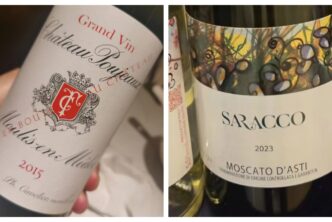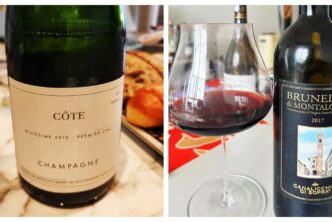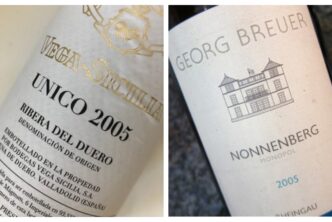Chateau Mouton Rothschild 1870 Mouton Rothschild Pauillac Grand Cru Classé Unscorable!
by Robert Millman

That is not a misprint. It is as the label says: Mouton 1870.
The attached photographs are actual shots of the bottle as it was served at the famous Enoteca Pinchiorri on Tuesday evening November 14th, 2023. I had received a phone call ten days before from my old friend Dr. Harry Snady and his lovely wife Laurel inviting me to join them for what would be a momentous occasion. Unfortunately, I was not able to make the trip—one of the ultimate regrets of my life. Little did I know that Harry, ever mindful of all aspects of every situation, would Coravin the bottle and bring it back to the New York so that I would be able to smell and taste the last few ounces of the wine.
Harry had purchased the wine many years ago and during one of their several pilgrimages to the famous Florentine restaurant brought it to be stored and have it served at a later date. That was 30 years ago! The best 1870s are considered among the best wines made in Bordeaux in the nineteenth century. Edmund Penning Rowsell in his indispensable The Wines of Bordeaux describes tasting the 1870 Mouton several times at Mouton noting its “…splendid nose and depth of flavor.” Perhaps the most tannic of the best vintages after the classification of 1855, the 1870s were not considered to be fully drinkable until the 1920s. The four top wines of that legendary vintage were Mouton, Latour, Lafite and Leoville Las Cases. (I add parenthetically that it was due to Harry’s generosity that I also tasted the 1900 Las Cases in Paris in 2001 twelve hours after it had been opened. At 100 years old, it was a wine of such depth and power like I had never before experienced).
Back to the 1870 Mouton: I tasted these precious ounces at Harry and Laurel’s New Jersey home and office, with its indescribable view of the Manhattan skyline on a dreary, rainy Sunday late afternoon. We dined on sliced duck breast served over truffle-infused pici pasta moistened with a cream sauce with chanterelles. The wine clearly demanded rich, earthy food.
Now to the wine: The color was remarkably bright and lively with only a minor amount of browning. I have tasted Mouton enough times—the benefit of running wine events for many years—to recognize the color. Not as dark as Latour, more magenta and luminosity–even at 150 years old! The bouquet was intensely perfumed with the living remnants of fruit but much more mineral and earth scented. On the palate, the wine exhibited a lively vigor that is all but impossible to explain. Tannins were gone but the acidity was still humming. Nearly three weeks after opening, the wine was healthy and alive. With an hour of air the wine turned dark—the glass showed chunky sediment—and the aroma was now pure mineral/truffle/tar. I cannot say that this was the best wine I have ever tasted. It may, in full context, have been the most memorable. There is no way to assign points to such a wine (and that’s why I wrote “unscorable”!). It is bottle by bottle. Harry had purchased a bottle in pristine condition and it had been cellared perfectly. All this helped this masterpiece stay alive for what seems like an all but incredible amount of time.
Mr.K/Sine Qua Non 2001 Semillon The Straw Man California 97

Luminous amber-gold colour, not unlike caramel. Very intense, penetrating aromas of candied kumquat, glazed pineapple, roasted banana, caramel, cherry tree honey, sweet spices, coffee and crystallized citrus fruits. Then rich, dense and almost treacly, with flavours that are very similar to the aromas, plus added notes of figs, of dates and raisins. The finish goes on and on, such that describing it as “endless” isn’t really that much of an exaggeration. Made in the manner of France’s Vin de Paille , by air-drying the Semillon grapes, the team of Kracher and Krankl have come up with a truly unforgettable wine. It really boasts remarkable balance: its almost incredible 371 g/L of residual sugar nicely is buffered by 8.63 g/L of total acidity, such that while undeniably sweet, luscious and viscous, it never tastes cloying or heavy at all. In fact, unless you are amongst those who really does not have a sweet tooth, you’ll find yourself wanting to refill your glass up again as soon as you empty it, always a great sign when dealing with sweet wines. But there are two other points of merit to this wine. First, it showcases just how noble a variety Semillon is, because very few wine grapes anywhere in the world can give a similar result (certainly neither Chardonnay nor Sauvignon Blanc, for all their fame). Second, even at twenty-three years out, this is still very young and will have no trouble living for another decade or so if kept in a good cellar. What else can I say, except that my hat’s off? Well done! Drinking window: 2023-2030.

 中文
中文



